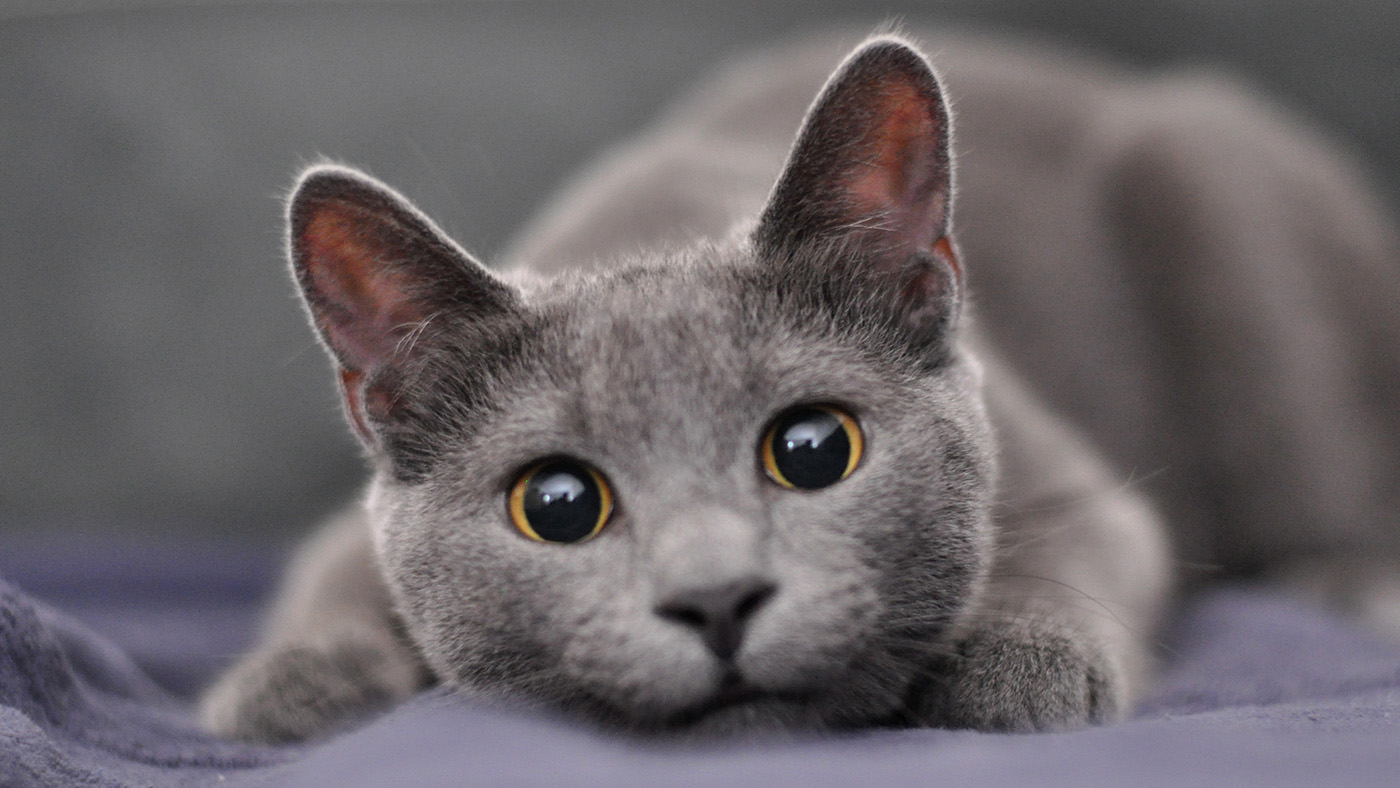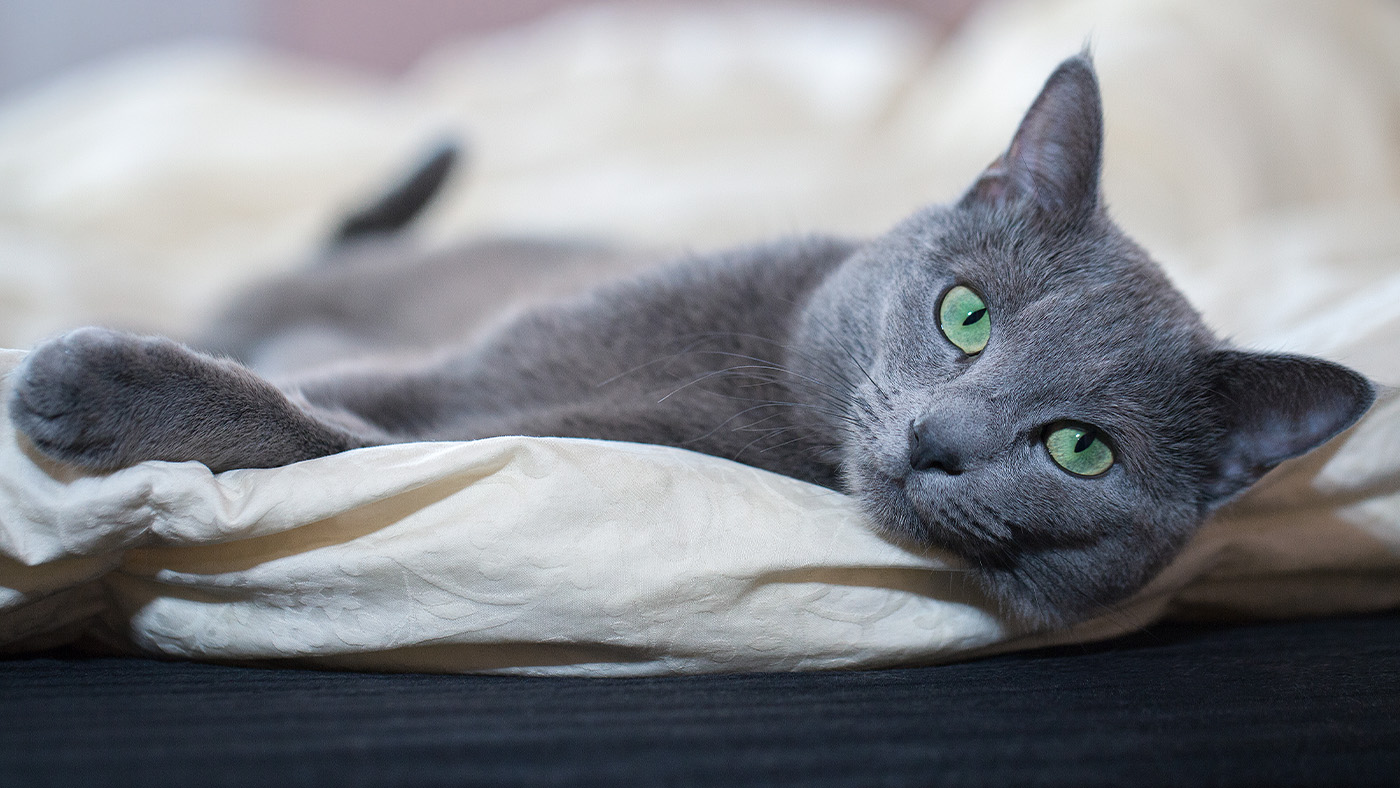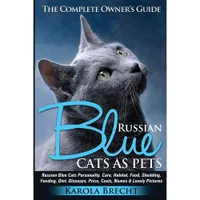Russian Blues are beautiful, low-maintenance and long-living – what more could you want?
Intelligent, sweet-natured and relatively quiet, discover whether a Russian Blue could be right for your home


Other names: Archangel Blues
Life expectancy: 15–20 years
Size: 8-10 inches (height), 15–18 inches (length) and 8–15 lb (weight)
Coat: solid steel blue
Eye colour: green eyes
Temperament: devoted, intelligent, sensitive and intuitive
Origin/native country: Russia
Celebrated for their blue-silver coats, elegant build and low-key energy, the Russian Blue is the perfect mix of beauty and grace. As their name suggests, these feline companions hail from Russia – in the bustling port city of Arkhangelsk, to be exact – and they are a naturally occurring breed.
They get their name because of their illustrious blue coat that has a silvery sheen throughout. You might think all this fur requires hours worth of upkeep, but the truth is, Russian Blues are pretty low maintenance on all fronts. This breed can also be a godsend for allergy-prone households because Russian Blues produce less of the allergy-triggering protein found in cats when compared to other breeds.
Another fun fact about this beautiful, long-living breed? They are an intelligent, relatively independent and quiet breed, so are best suited for homes that can match this understated energy. If you’re considering bringing a Russian Blue home, you’ll find everything you need to know in this guide, including their health conditions, enrichment needs, and more.
Are Russian Blue cats hypoallergenic?
“Russian Blue cats are not truly hypoallergenic, but may suit some owners with mild allergies,” explains vet Dr Rebecca MacMillan. “This is because Russian Blues produce less Fel d1 protein in their saliva and urine than many other breeds,”.
In the cat realm, Fel d1 is the protein that triggers reactions in those allergic to cats. Therefore, if you are in an allergy-prone household, it’s worth reading up on the hypoallergenic cat breeds, like the Siamese, Burmese and the LaPerm, as these pets either produce less of the allergy-triggering protein and/or don’t shed too much, which can make them an ideal proposition for allergy sufferers.
Do Russian Blue cats shed?
Russian Blues do shed some of their shimmering coat, but only minimally so this means you won’t find too many loose hairs around your home!
“This can also help allergy sufferers as there will be less saliva-coated hair and dander in the environment,” Dr MacMillan says. “Just remember that very sensitive people may still react.”
Get the best advice, tips and top tech for your beloved Pets
For those who would prefer not to have tons of fur all over their clothing, floors and furniture, the non-shedding cat breeds are well worth considering.
How long do Russian Blue cats live?
Russian Blue cats are pretty long-living cats. So much so, many Russian Blues live until they are between 15–20 years of age with the right care.
According to Dr MacMillan, if you want to increase the chances of your cat having a long and healthy life, then there are several things you can do.
“Make sure they are receiving the correct amount of a good quality diet, appropriate for their age and lifestyle,” the vet notes. “Also monitor their weight closely, as cats that are overweight or obese can have significantly shorter life spans."
Thirdly, Dr MacMillan suggests taking your cat to the vets for routine check-ups and ensuring they have all the recommended vaccinations.
“This will keep them safe from potentially fatal diseases,” she says.
While regular anti-parasite treatment, like the best flea treatments for cats, will also help to keep them healthy, as will regular preventative oral care.

How much grooming does a Russian Blue cat need?
If you’re considering adopting a Russian Blue, you’ll be pleased to know that these cuties have easy grooming requirements.
“Their short coat only needs brushing once a week to remove any loose hairs,” Dr MacMillan says. “I also recommend introducing regular oral care from an early age. Many cats will tolerate gentle toothbrushing with cat-safe toothpaste, if you encourage this with positive reinforcement training.”
As Dr MacMillan says, to help keep cat teeth clean, it’s important to get into a good teethbrushing routine. It’s also well worth learning how to brush your cat’s teeth, so that you can avoid dental disease, like stomatitis and gingivitis, and boost your cat’s longevity and quality of life.
How much exercise does a Russian Blue cat need?
Russian Blues have moderate exercise needs and are not as demanding as some other cat breeds, like an Abyssinian, Bengal or Siamese, which are all high-energy cat breeds that will want to play with you all the time.
“Around 30 minutes of activity a day should be enough to keep them happy,” Dr MacMillan says.
So, if you plan on bringing a Russian Blue home, the best cat toys and the best automated cat toys will help keep your kitty entertained.
Wisdom Panel Cat DNA Test | Amazon
Not sure exactly what breed your cat is? This kit screens for 70+ breeds, 45 genetic health insights and 25+ physical traits – because knowing every detail about your cat helps you understand how best to care for them.
Russian Blue health problems
Dental disease is common in many cats and Russian Blues are no different because dental issues in cats often go unnoticed.
“Excessive tartar buildup and gum inflammation can lead to tooth loss,” explains Dr MacMillan. “That is why preventative oral care is so important.”
Obesity is another health condition common in Russian Blues, as it can be hard to say no to those cute little faces!
“However, obesity is linked to an increased risk of other ailments like diabetes, joint disease, and cancer,” Dr MacMillan highlights. “Owners must weigh their pet’s food out carefully and keep an eye on their cat’s body condition, to ensure they don’t put on any extra pounds.”
As with many pedigree breeds, hypertrophic cardiomyopathy can be a problem for Russian Blues.
“This condition causes thickening of the muscular heart walls,” the vet explains. “This affects the heart’s ability to effectively pump blood around the body. Heart failure can occur, as well as blood clots and sudden death.”
Hypertrophic cardiomyopathy is an inherited condition so purchasing your kitten from a reputable breeder who has screened their cats will reduce the risk.
Asthma in cats isn’t uncommon and it’s a respiratory condition that can affect this breed.
“In affected cats, the body overreacts to inhaled allergens leading to inflammation and constriction of the airways,” Dr MacMillan says. “Asthmatic cats can have breathing difficulties, wheezing, and start open-mouth breathing.”
If any of these symptoms occur, owners must seek urgent help from a vet if their cat is showing any signs of asthma.
“Reducing things like cigarette smoke, air fresheners and scented candles in the environment can help ease symptoms, but many cats will require long-term medication too,” Dr MacMillan adds.
How much does a Russian Blue cost?
Russian Blues are pretty expensive cats. Costing anywhere between $1,400–3,800, their distinct appearance and pleasing personality traits make them particularly desirable – and therefore on the pricier side. This is around the same price tag as a Bengal or Savannah cat.
Though Russian Blues aren’t considered to be one of the rarest cat breeds in the US, they aren’t your everyday cat you might come across.
Should I get a Russian Blue?
That depends. The long-living Russian Blues are sweet-natured kitties who thrive in human company.
These cats are a relatively quiet breed and can get a bit scared by noisy children, bouncy dogs, or strangers. This is why Dr MacMillan suggests they would be best suited to a peaceful household, perhaps an elderly owner or a family with calmer, older children.
Due to the fact Russian Blues produce less Fel d1 protein in their saliva and urine than many other breed and shed minimally, this breed might also suit allergy sufferers or those who don’t want to spend all day picking up after their kitty.
Although they enjoy playing, they also like a bit of alone time and will often take themselves off for a nap.
“They are usually content being left for short periods too, if you need to head out for a bit,” Dr MacMillan adds.
Russian Blue Cats As Pets | Amazon
This book covers the ideal habitat, food, shedding, feeding, diet and diseases – all specific to Russian Blues – and is written to help to those who desire advice and a better understanding for their new or existing companion.
Read next: Facts about Russian blue cats

Having graduated in 2009 from the Royal Veterinary College in London as a veterinary surgeon, Rebecca is highly experienced in first opinion small animal practice, having done a mixture of day-to-day routine work, on-call emergency duties and managerial roles over the years. Rebecca recently achieved a BSAVA postgraduate certificate in small animal medicine (with commendation).
Rebecca writes on various feline and canine topics, including behavior, nutrition, and health. Outside of work and writing she enjoys walking her own dog, spending time with her young family and baking!
Edited by Georgia Guerin.
This feature was last updated in July 2025 by Becks Shepherd.

Becks Shepherd is a lifestyle journalist who has worked with titles such as Tom's Guide, Marie Claire, and Fit and Well.
In addition to this, she’s a pet writer with nearly a decade of editorial experience across digital and print media. A devoted “dog aunt” and lifelong animal lover, Becks brings a personal touch to her pet content—whether she’s testing the latest dog gear or digging into behavioral tips.
She works closely with veterinary experts to ensure factual accuracy and is currently exploring animal care certifications to deepen her knowledge. Her work has appeared in leading outlets across health, wellness, and pet care spaces.


